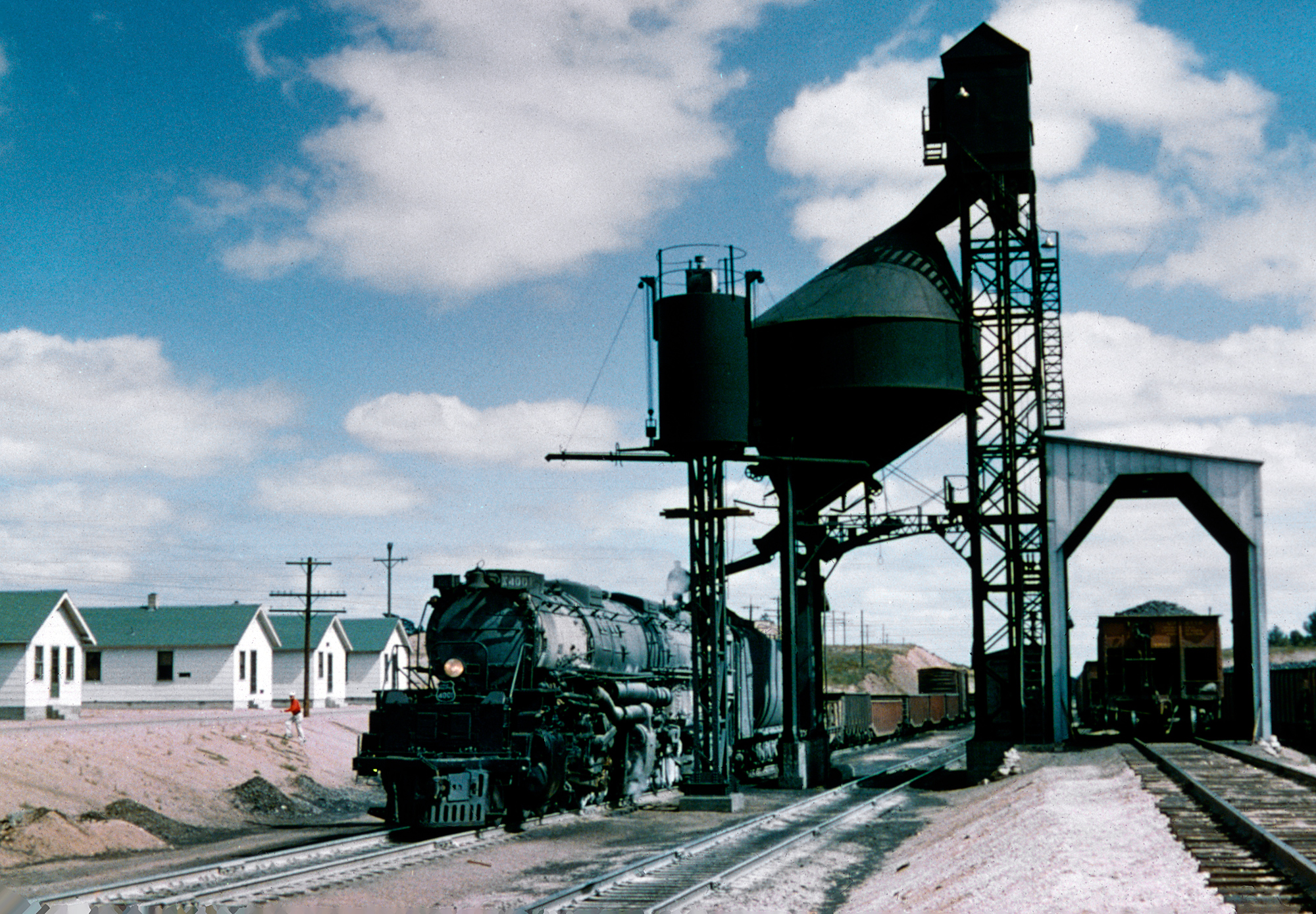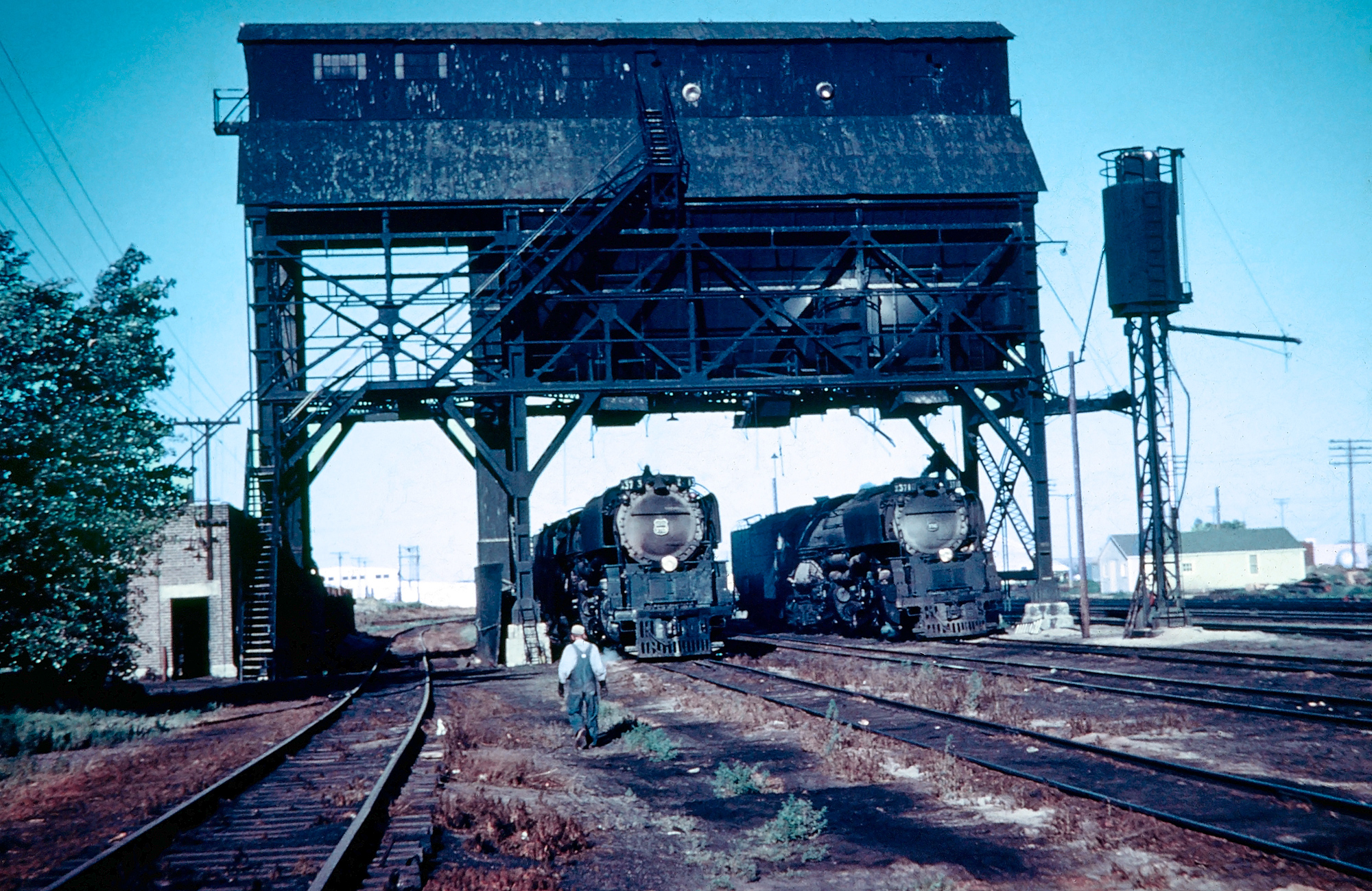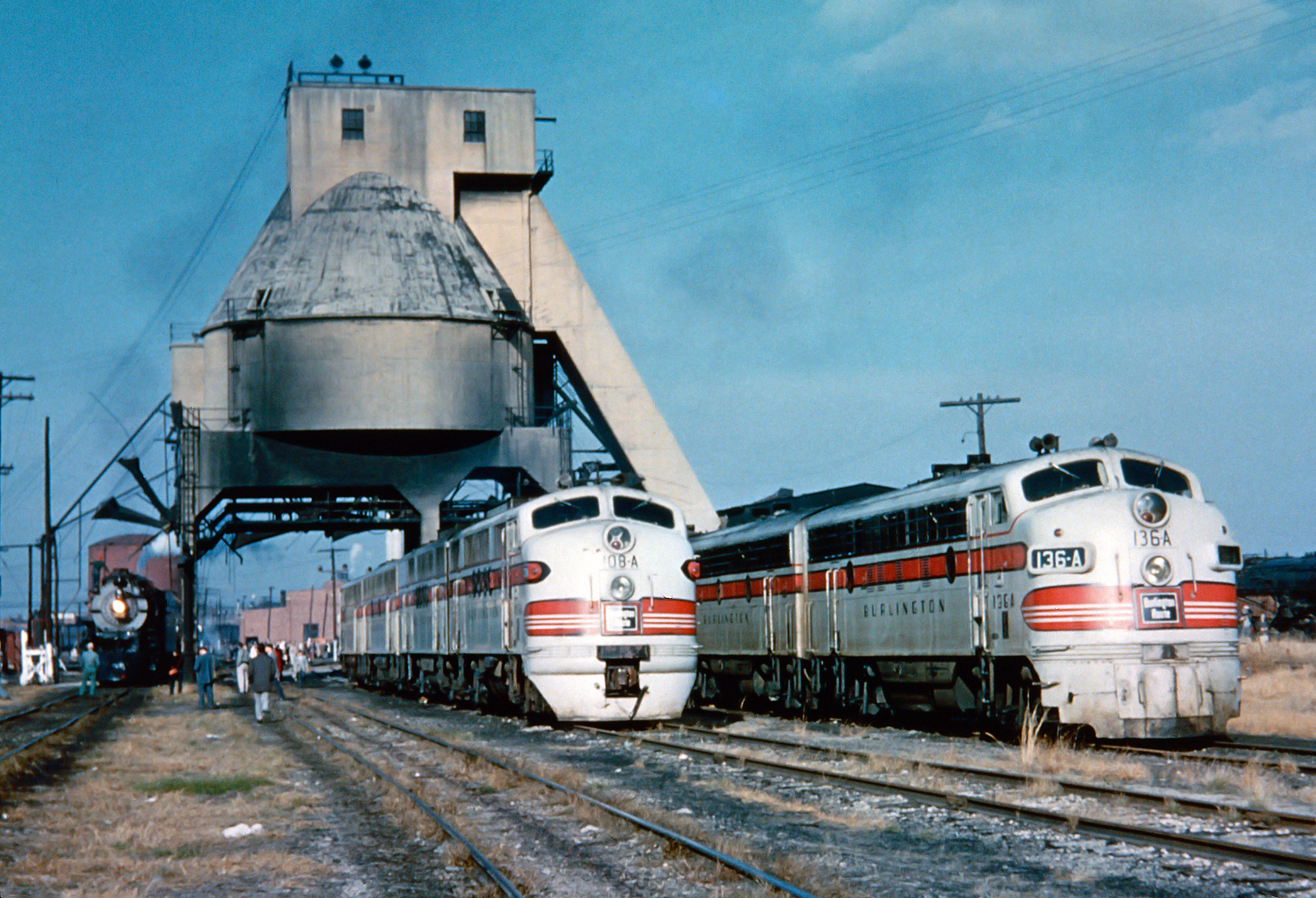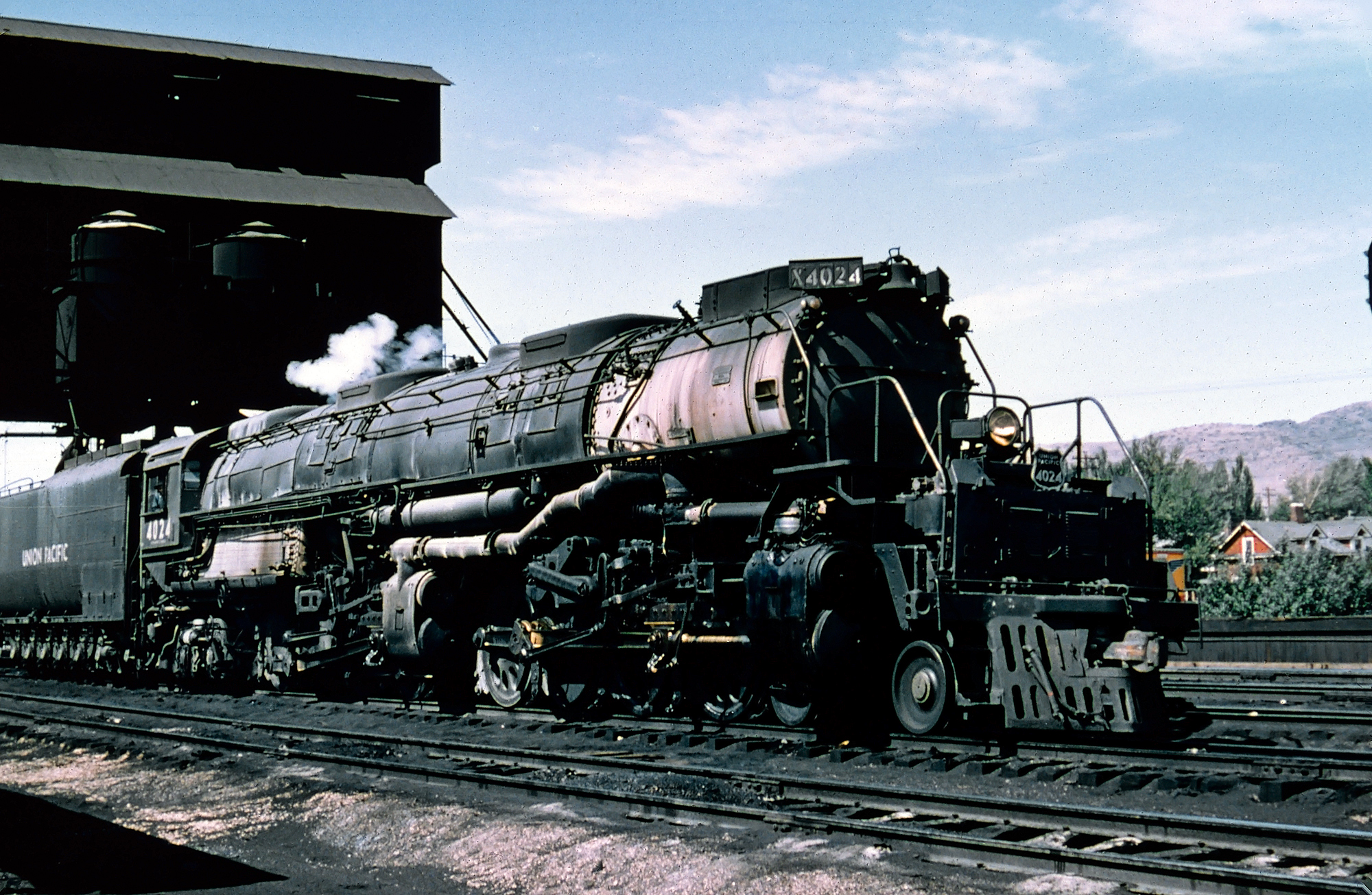Coaling Towers, Keeping Engines Fueled
Last revised: November 5, 2024
By: Adam Burns
During the age of the steam locomotive coaling towers were an essential part of railroading as without them there was little way to effectively fuel the motive power.
The coal chute or coaling station, as it is also sometimes known, dates back to the late 1800s as steam locomotives became larger and required a larger fuel capacity.
As with steam locomotives themselves there were all different sizes of towers and they became much larger into the 20th century.
Some of the last towers ever built were from reinforced concrete and stood hundreds of feet tall. Today, of course, the structure's purpose has long since ended.
However, several of the last towers constructed were so well built that several still stand to this day, over a half-century since they were last used!
Photos
 Union Pacific 4-8-8-4 "Big Boy" #4001 takes on fuel at the small coaling tower in West Harriman, Wyoming on September 5, 1956. J.E. Shaw photo. American-Rails.com collection.
Union Pacific 4-8-8-4 "Big Boy" #4001 takes on fuel at the small coaling tower in West Harriman, Wyoming on September 5, 1956. J.E. Shaw photo. American-Rails.com collection.History
Steam Locomotives, devices that would literally drive and power the American railroad industry for its first 130+ years of existence actually has its origins in England.
Originally built by Richard Trevithick and Andrew Vivian in 1804 for the narrow gauge Penydarren tramway in Wales the contraption was first tested in America in August of 1829.
It was on the Delaware & Hudson Canal Company where Horatio Allen, its chief engineer for the Delaware & Hudson, tested an early English steam locomotive design on a 16-mile stretch of track the company owned between Honesdale and Carbondale, Pennsylvania.
The locomotive used was named the Stourbridge Lion, which was a very simple two-axle machine with a vertical boiler, and it was employed to move coal from the mines at Carbondale to Honesdale.
 Union Pacific 4-6-6-4s #3713 and #3710 sit under the large coaling tower at Sidney, Nebraska near the end of their careers, circa 1958. These locomotives had brief, but interesting, careers: they were built in 1943 by Alco as #3977 and #3980; renumbered 3817 and 3820 in 1944; regained their original numbers in 1945 when converted to oil; switched back to coal burners in 1946, converted to oil again in 1949, and finally renumbered 3710 and 3713 in 1952. Richard Wallin photo. American-Rails.com collection.
Union Pacific 4-6-6-4s #3713 and #3710 sit under the large coaling tower at Sidney, Nebraska near the end of their careers, circa 1958. These locomotives had brief, but interesting, careers: they were built in 1943 by Alco as #3977 and #3980; renumbered 3817 and 3820 in 1944; regained their original numbers in 1945 when converted to oil; switched back to coal burners in 1946, converted to oil again in 1949, and finally renumbered 3710 and 3713 in 1952. Richard Wallin photo. American-Rails.com collection.Until the 20th century virtually all steam locomotives coal as their primary fuel source (although very early locomotive designs, like 4-4-0 Americans used wood) with large tenders of water to produce the necessary steam.
The operations of steam locomotives are relatively
simple, which I will try to explain just briefly. Fuel, usually either coal
or oil, is fed into the firebox where the resulting hot gas enters
boiler tubes, known as flues, to heat the surrounding water turning it
unto steam.
From this point the steam is fed into the pistons whereby it expands and drives the steam locomotive’s rods (those massive steel shafts which are attached to the wheels) and propels it forward.
 Chicago, Burlington & Quincy cab units sit near the coaling tower in Galesburg, Illinois while 4-8-4 #5632 has attracted a lot of attention at left, circa 1964. The Northern was still leading excursions at this time. The cab units include FT #108-A and an FTB (with what appears to be two F3B's trailing) at left while an F3 A-B set is at right, led by #136-A. American-Rails.com collection.
Chicago, Burlington & Quincy cab units sit near the coaling tower in Galesburg, Illinois while 4-8-4 #5632 has attracted a lot of attention at left, circa 1964. The Northern was still leading excursions at this time. The cab units include FT #108-A and an FTB (with what appears to be two F3B's trailing) at left while an F3 A-B set is at right, led by #136-A. American-Rails.com collection.The hot gases are then carried into the smoke box where they are funneled into the smoke stack and out of the locomotive.
A quick note about the "modern" steam locomotive smoke stacks, most carry grating or some other type of screening to help reduce the amount of cinders (especially in the case when wood was used as fuel) which are projected into the air and can cause brush fires.
Operations
Coaling towers grew in size as needed with increasingly larger steam locomotives. Some of the first coaling towers were only a few stories tall and held less than 100 tons of coal usually also only serving one track.
However, as larger locomotives like 4-6-2 Pacifics, 2-8-4 Berkshires and 4-8-4 Northerns were introduced in the late 19th and early 20th centuries it was obviously necessary to increase the tower's size.
The workings of a coaling towers are relatively simple. They were always gravity fed with the steam locomotive sitting below or nearby (if the tower employed chutes) and an operator would feed coal into the tender until it was topped off.
To refill the towers they usually had a staging track or an area where loaded hopper cars could be unloaded and a pulley/belt driven system would pick up the coal and load the bin.
Early systems were rudimentary using straight chain and pulley buckets but later systems used conveyor belts to efficiently load the coaling towers.
 Union Pacific 4-8-8-4 "Big Boy" #4024 simmers away near the coaling tower at Rawlins, Wyoming on September 4, 1956. John Shaw photo. American-Rails.com collection.
Union Pacific 4-8-8-4 "Big Boy" #4024 simmers away near the coaling tower at Rawlins, Wyoming on September 4, 1956. John Shaw photo. American-Rails.com collection.Decline
At their peak coaling towers were impressive structures standing multiple stories high and looking more like massive grain bins one might see out on the plains.
They were also built of reinforced concrete and either straddled multiple railroad tracks or used chutes to load as many locomotives at once as was possible to achieve economies of scale.
Unfortunately, these newer coaling towers were so well built that many have proven too expensive for railroads to demolish and several can still be found dotting the landscape across the country, abandoned sentinels of a bygone era of railroading.
Recent Articles
-
Rio Grande 2-8-2 Locomotives (K-37): Specs, Roster, Photos
Apr 15, 25 12:57 PM
Rio Grande's Class K-37 Mikes were itsdge steamers to enter service in the late 1920s. Today, all but two survive. -
Rio Grande 2-8-2 Locomotives (K-36): Specs, Roster, Photos
Apr 15, 25 11:09 AM
The Rio Grande's K-36 2-8-2s were its last new Mikados purchased for narrow-gauge use. Today, all but one survives. -
Rio Grande 2-8-2 Locomotives (Class K-28): Specs, Roster, Photos
Apr 14, 25 10:24 PM
Rio Grande's Class K-28 Mikados were its newest narrow-gauge steam locomotives since the Mudhens of the early 1900s. Today, three survive.


